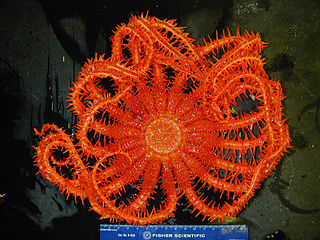
Starfish or sea stars are star-shaped echinoderms belonging to the class Asteroidea. Common usage frequently finds these names being also applied to ophiuroids, which are correctly referred to as brittle stars or basket stars. Starfish are also known as Asteroids due to being in the class Asteroidea. About 1,900 species of starfish occur on the seabed in all the world's oceans, from the tropics to frigid polar waters. They are found from the intertidal zone down to abyssal depths, 6,000 m (20,000 ft) below the surface.

The Valvatida are an order of starfish in the class Asteroidea, which contains 695 species in 172 genera in 17 families.

The Echinasteridae are a family of starfish in the monotypic order Spinulosida. The family includes eight genera and about 133 species found on the seabed in various habitats around the world.

Culcita is a genus of cushion stars. They are found in tropical waters. Some are kept in home aquariums.

The Brisingids are deep-sea-dwelling starfish in the order Brisingida.
Odontohenricia is a genus of starfish in the family Echinasteridae in the order Spinulosida.

The Mithrodiidae is a family of starfish in the order Valvatida.

Archasteridae is a family of starfish found in shallow waters in the tropical Indo-Pacific region. The genus Astropus, previously included in this family, is now included in the genus Archaster with the single species, Astropus longipes, being accepted as Archaster lorioli Sukarno & Jangoux, 1977.
Stylasterias is a genus of starfish in the family Asteriidae. Stylasterias forreri, the velcro star, is the only species in the genus. It is found on the Pacific coast of Canada and the United States.
Parvulastra parvivipara is a very small species of starfish in the family Asterinidae. It is a viviparous species and gives birth to live young. It lives in rock pools on intertidal granite rocks in a limited area of South Australia.

Poraniidae is a family of starfishes in the order Valvatida.

Nepanthia is a genus of starfish of the family Asterinidae. Members of the genus have four to seven rays and are found in the eastern Pacific Ocean, ranging from Burma and Indonesia to Australia.
Trophodiscus is a genus of starfish in the family Astropectinidae. There are only two species, both found in fairly deep waters in the Sea of Okhotsk. Trophodiscus almus is also found in the Sea of Japan and around the Japanese island of Hokkaido. These starfish are very unusual in that the young are brooded on the upper surface of the female.

Fromia ghardaqana, common name Ghardaqa sea star, is a species of marine starfish in the family Goniasteridae.

Astroceramus is a genus of abyssal sea stars in the family Goniasteridae.

Apollonaster is a genus of abyssal sea stars in the family Goniasteridae. They can be identified by their bare abactinal plate surfaces and multiple accessory granule rows on their abactinal plates. To date, Apollonaster has been found in the tropical Atlantic region and Hawaiian Islands region oceans, with no other locations or species being known as of 2015.

Asterodiscididae is a family of starfish. Members of the family have five short tapering arms and a wide disc. The family was first described by the Australian zoologist F.W.E. Rowe in 1977.

Meyenaster is a genus of starfish in the family Asteriidae. It is a monotypic genus and the only species is Meyenaster gelatinosus which was first described by the Prussian botanist and zoologist Franz Julius Ferdinand Meyen in 1834. It is found in the southeastern Pacific Ocean on the coasts of South America.

Thromidia catalai is a species of starfish in the family Mithrodiidae in the order Valvatida. It is native to the Indo-Pacific region. Thromidia catalai is one of the largest and heaviest starfishes in the world. It is reported to weigh as much as 6 kg (13 lb) and have a diameter of 60 to 65 cm. This species was first described by the Australian biologists E. C. Pope and F. W. E. Rowe in 1977, the type locality being New Caledonia.
Thromidia seychellesensis is a species of starfish of the Mithrodiidae family and was decsribed in 1977.














